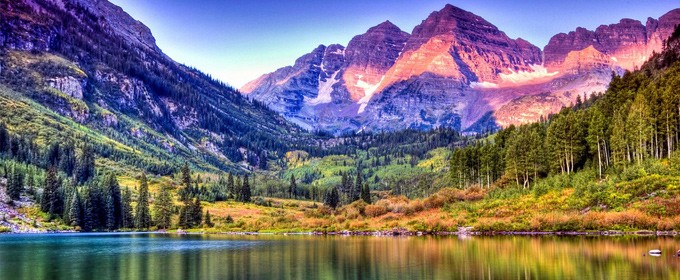Colorado is known as the “Centennial State.” This state encompasses most of the Southern Rocky Mountains, as well as the northeastern portion of the Colorado Plateau, and the western edge of the Great Plains. Colorado is noted for its vivid landscape of mountains, forests, high plains, mesas, canyons, plateaus, rivers, and desert lands.
Colorado is part of the Western United States, the Southwestern US, and the Mountain States time zone. Colorado is bordered by the northwestern state of Wyoming, the Midwest states of Nebraska and Kansas (to the northeast and east), on the south by New Mexico and Oklahoma, on the west by Utah, and Arizona to the southwest. The four states of Colorado, New Mexico, Utah, and Arizona meet at one common point known as the Four Corners, which is largely considered the heart of the American Southwest.
Colorado is known for its incredible geography which ranges from the alpine mountains, plains and deserts with great sand dunes, deep canyons, sandstone and granite rock formations, rivers, lakes, and lush forests. Colorado is the only U.S. state that lies entirely above 1000 meters elevation, it’s lowest point being 3,317 feet elevation. The Rocky Mountains in Colorado contain about fifty-three peaks that are 14,000 feet or higher above sea level, but only small parts of the Colorado Rockies are snow-covered all year. The thirty highest summits of the Rockies are all in Colorado.
Eastern Colorado is mainly covered in farmland, along with small farming villages and towns. Corn, wheat, hay, soybeans, and oats are the main crops, with a sizable amount of cattle ranches and hog farms as well.
Colorado is home to four national parks, eight national monuments, two national recreation areas, two national historic sites, three national historic trails, one national scenic trail, eleven national forests, two national grasslands, forty-two national wilderness areas, two national conservation areas, eight national wildlife refuges, forty-four state parks, 307 state wildlife areas, and numerous other scenic, historic, and recreational areas.
The cost of living in Colorado is lower than the US average and rising slowly but steadily, with prices of gas, rent, food and clothes increasing approximately two percent each quarter. Denver is the capital and the most populated city in the state. Colorado has a 4.63% income tax, that doesn’t change with your income level. Unlike most states, which tax based on adjusted gross income, Colorado taxes are based on taxable income – “income after federal exemptions and federal itemized (or standard) deductions”. The state sales tax is 2.9%. It is the fifth richest state in the US, with per capita household income exceeding $100,000 in some areas. The state’s average per capita household income is $56, 456, above the country’s average by a couple thousand. The unemployment rate is 5.3%
The state is home to a network of US and Colorado highways that provide access to all principal areas of the state. Smaller communities are only connected to this network via county roads, with some of the best maintained roads in the country. Denver International Airport (DIA) is the fourth busiest domestic U.S. airport and thirteenth busiest world airport. There are two main Amtrak lines in the state and an extensive public transportation system.
Colorado combines the best of both worlds with it’s scenic mountainous beauty that serves as the backdrop for it’s bustling metropolitan areas in it’s major cities. The unique state is known for it’s wines and beers as well, adding to it’s appeal. In it’s lavish, wealthy area of Aspen, the Wine and Food classic is held annually. Aspen is also known as the food destination of the state, due to it’s wealthy appeal attracting restaurateurs and vice-versa. Colorado is also known for it’s film and art scene. The state offers a comprehensive list of museums and established, well-known film festivals as well.
Colorado has significant hydrocarbon resources, and according to the Energy Information Administration, Colorado hosts seven of the Nation’s 100 largest natural gas fields and two of its 100 largest oil fields. Colorado is considered to have the third largest uranium reserves of any US state, behind Wyoming and New Mexico. In addition to the already existing energy by fuel sources, Colorado is looking into using its geographical qualities to its advantage. With its high peaks and open areas could be potential wind and solar farms, and its large corn production could go toward producing ethanol.
Colorado has a large school system that compares favorably to the rest of the US. The state has an extensive public and private college and university system.
Colorado combines the best of both worlds with large, bustling metropolitan cities full of quality museums, cuisine, and life and a breathtaking Rocky Mountain back drop. It’s a great option for the more outdoorsy types or those of us who want to stay with in the city life but with the added benefit of an incredible view you can’t get anywhere else.

